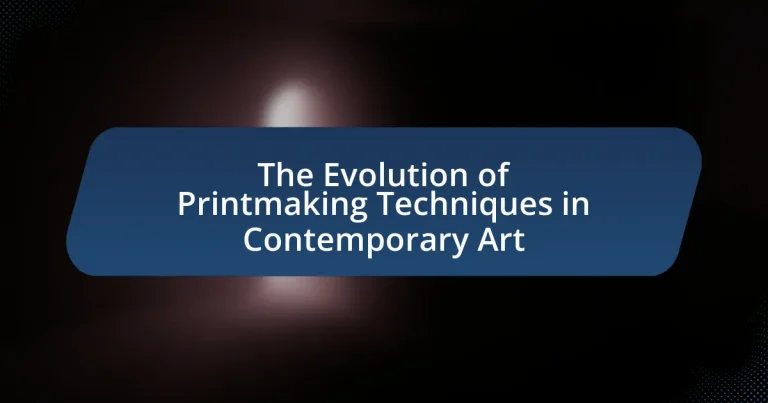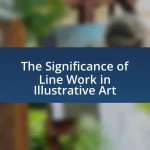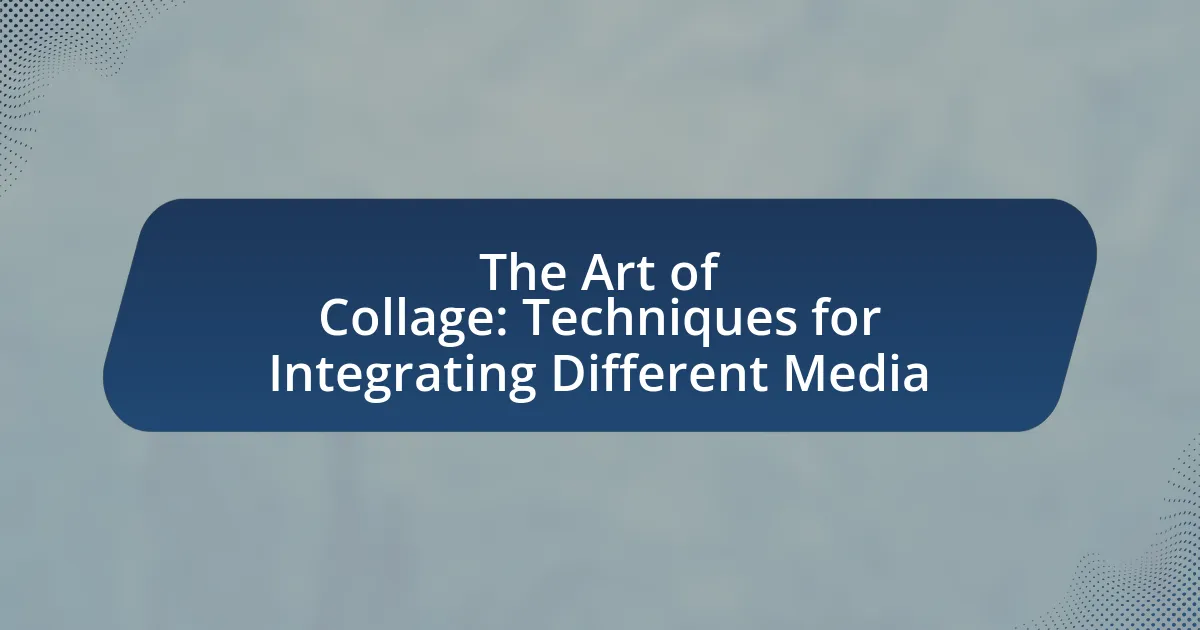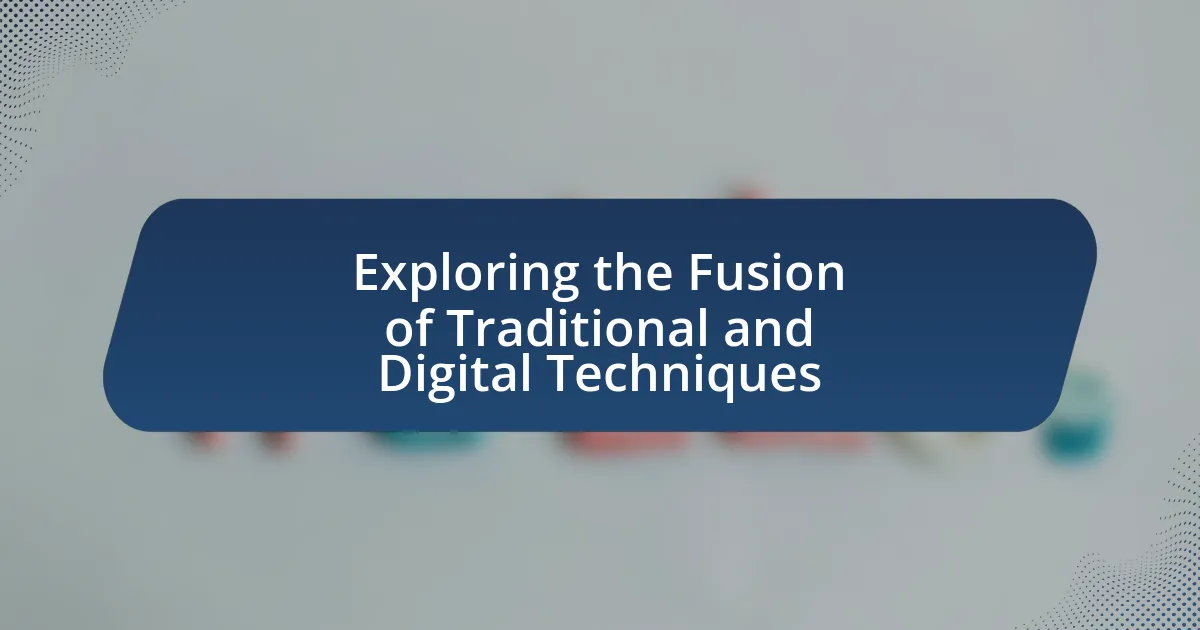The article examines the evolution of printmaking techniques in contemporary art, highlighting key methods such as digital printing, screen printing, and monotype. It discusses how traditional printmaking techniques, including woodcut and etching, have influenced modern practices and how artists integrate these methods with contemporary themes and technologies. The role of technology, particularly digital advancements and 3D printing, is explored, along with the implications of sustainability and environmental concerns in printmaking. Additionally, the article addresses the challenges faced by contemporary printmakers, including economic barriers and the impact of social and political issues on their work.

What are the key printmaking techniques that have evolved in contemporary art?
Key printmaking techniques that have evolved in contemporary art include digital printing, screen printing, and monotype. Digital printing has transformed the medium by allowing artists to create high-quality prints directly from digital files, enabling intricate designs and vibrant colors. Screen printing, popularized by artists like Andy Warhol, has evolved with new materials and methods, allowing for greater experimentation and layering. Monotype, characterized by its unique, one-of-a-kind prints, has gained traction as artists explore spontaneity and texture. These techniques reflect the integration of technology and traditional methods, showcasing the dynamic nature of contemporary printmaking.
How did traditional printmaking techniques influence contemporary practices?
Traditional printmaking techniques have significantly influenced contemporary practices by providing foundational methods and aesthetic principles that artists continue to explore and innovate. Techniques such as woodblock printing, etching, and lithography have informed contemporary artists’ approaches to texture, layering, and composition. For instance, the revival of screen printing in contemporary art, popularized by artists like Andy Warhol, showcases how traditional methods can be adapted to modern themes and technologies. Additionally, the emphasis on craftsmanship and the tactile quality of prints from traditional practices has led contemporary artists to value the physicality of their work, often merging digital and analog processes to create hybrid forms. This blending of old and new reflects a continuity in artistic exploration, demonstrating that traditional printmaking remains a vital influence in the evolution of contemporary art.
What are the main traditional printmaking techniques that have been adapted?
The main traditional printmaking techniques that have been adapted include woodcut, etching, lithography, and screen printing. Woodcut, one of the oldest techniques, has been modernized through the use of new materials and tools, allowing for more intricate designs. Etching has evolved with the introduction of digital processes, enabling artists to combine traditional methods with contemporary technology. Lithography has seen adaptations in both the materials used and the printing process, allowing for greater versatility and expression. Screen printing has expanded beyond textiles to include fine art prints, utilizing innovative inks and substrates. These adaptations reflect the ongoing evolution of printmaking in contemporary art, blending historical techniques with modern practices.
How have artists integrated traditional methods into modern contexts?
Artists have integrated traditional methods into modern contexts by blending historical printmaking techniques with contemporary themes and technologies. For instance, artists like Kara Walker utilize woodcut techniques to address modern social issues, creating powerful narratives that resonate with current audiences. Additionally, the use of digital tools alongside traditional methods, such as screen printing, allows for innovative expressions while maintaining the essence of the original techniques. This fusion not only preserves the cultural significance of traditional practices but also enhances their relevance in today’s art landscape, as seen in exhibitions that showcase both historical and contemporary works side by side.
What role does technology play in the evolution of printmaking?
Technology plays a crucial role in the evolution of printmaking by enhancing techniques, expanding creative possibilities, and increasing accessibility. The introduction of digital tools, such as computer software and high-resolution printers, has transformed traditional printmaking methods, allowing artists to experiment with new forms and styles. For instance, the advent of digital printing techniques, like giclée, enables the reproduction of artworks with exceptional detail and color accuracy, which was not possible with earlier methods. Additionally, advancements in laser cutting and 3D printing have introduced innovative approaches to creating prints, further diversifying the medium. These technological developments have democratized printmaking, making it more accessible to a broader range of artists and enabling the integration of printmaking into various contemporary art practices.
How has digital technology transformed printmaking techniques?
Digital technology has significantly transformed printmaking techniques by introducing methods such as digital printing, which allows for greater precision and customization. Traditional printmaking techniques, like lithography and etching, have been enhanced through digital tools that enable artists to create intricate designs and manipulate images with software before transferring them to print. For instance, the use of inkjet printers has expanded the color palette and detail achievable in prints, allowing for high-resolution outputs that were previously unattainable. Additionally, technologies like laser cutting and 3D printing have introduced new dimensions to printmaking, enabling artists to explore innovative forms and textures. This evolution reflects a shift towards a more accessible and versatile approach to printmaking, where artists can experiment freely and produce works that blend traditional craftsmanship with modern technology.
What are the implications of 3D printing in contemporary printmaking?
3D printing significantly transforms contemporary printmaking by enabling artists to create complex, three-dimensional forms that traditional printmaking techniques cannot achieve. This technology allows for greater precision and customization, facilitating the production of intricate designs and unique textures that enhance artistic expression. For instance, artists can now produce detailed sculptures and installations that incorporate both digital and physical elements, expanding the boundaries of what printmaking can encompass. Additionally, 3D printing democratizes the art-making process, as it reduces the barriers to entry for artists by making it easier to experiment with materials and forms. This shift is evidenced by the increasing number of exhibitions and artworks that integrate 3D-printed components, showcasing the medium’s growing acceptance and influence in the art world.
What are the contemporary trends in printmaking techniques?
Contemporary trends in printmaking techniques include the integration of digital technology, the use of sustainable materials, and the exploration of mixed media. Digital printmaking has gained prominence, allowing artists to manipulate images with software and produce high-quality prints using inkjet technology. Additionally, artists are increasingly opting for eco-friendly inks and papers, reflecting a growing awareness of environmental issues. The combination of traditional printmaking methods with other art forms, such as painting and sculpture, is also prevalent, enabling innovative expressions and expanding the boundaries of printmaking. These trends highlight the evolving nature of printmaking in contemporary art, showcasing both technological advancements and a commitment to sustainability.
Which new materials are being used in modern printmaking?
Modern printmaking utilizes innovative materials such as photopolymer plates, digital inks, and eco-friendly pigments. Photopolymer plates allow for precise image transfer and are favored for their ease of use and ability to produce high-quality prints. Digital inks, often used in inkjet printing, enable artists to create vibrant, detailed images directly from digital files. Eco-friendly pigments, derived from natural sources, are increasingly popular as artists seek sustainable practices in their work. These materials reflect a shift towards both technological advancement and environmental consciousness in contemporary printmaking.
How are contemporary artists pushing the boundaries of printmaking?
Contemporary artists are pushing the boundaries of printmaking by integrating innovative technologies and interdisciplinary approaches into traditional techniques. For instance, artists are utilizing digital printing methods, such as inkjet and laser printing, to create complex, layered works that were previously unattainable with conventional printmaking. Additionally, they are experimenting with non-traditional materials, like fabric and 3D-printed elements, which expand the tactile and visual possibilities of printmaking. This evolution is evidenced by exhibitions showcasing works that blend print with installation art, allowing for immersive experiences that challenge the viewer’s perception of the medium.
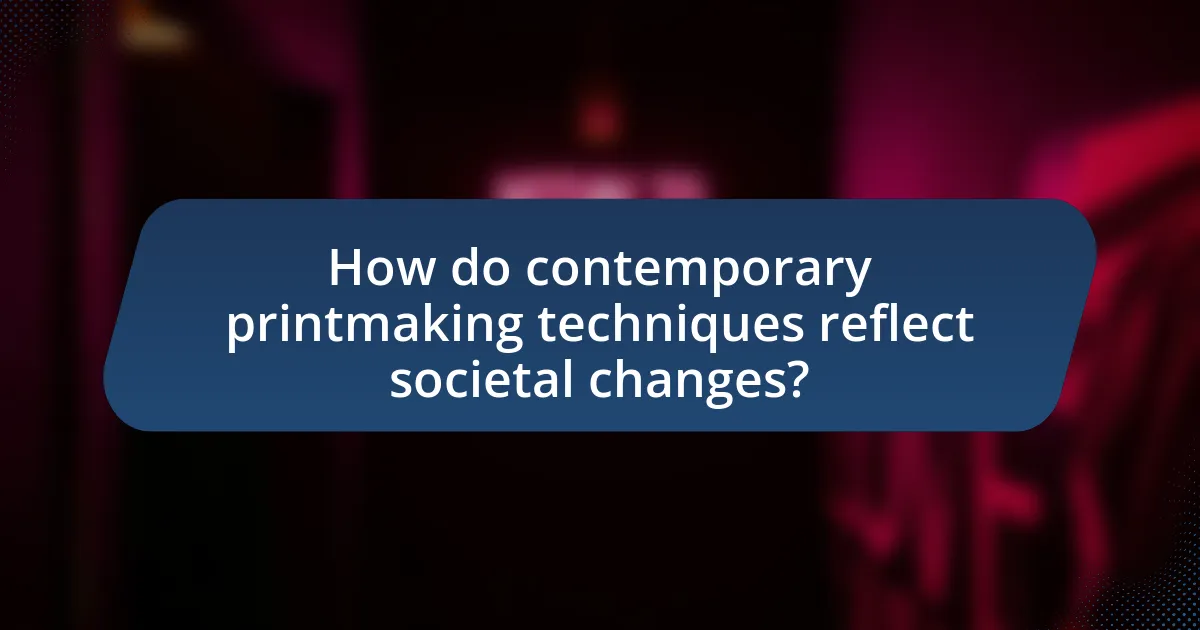
How do contemporary printmaking techniques reflect societal changes?
Contemporary printmaking techniques reflect societal changes by incorporating themes of identity, technology, and social justice into the artwork. Artists utilize innovative methods such as digital printing and mixed media to address contemporary issues, showcasing the impact of globalization and cultural diversity. For instance, the rise of digital printmaking allows for rapid dissemination of ideas, mirroring the fast-paced information exchange in society. Additionally, printmakers often engage with political and environmental themes, as seen in the works of artists like Kara Walker and El Anatsui, who challenge societal norms and provoke dialogue. This evolution in printmaking not only represents artistic innovation but also serves as a commentary on the shifting values and concerns of modern society.
What themes are prevalent in contemporary printmaking?
Contemporary printmaking prominently features themes of identity, social justice, and environmental awareness. Artists utilize printmaking techniques to explore personal and collective identities, often reflecting cultural backgrounds and experiences. For instance, many printmakers address social justice issues, using their work to comment on inequality, race, and gender dynamics, as seen in the works of artists like Kara Walker and El Anatsui. Additionally, environmental themes are increasingly prevalent, with artists highlighting ecological concerns and sustainability through their printmaking practices, as evidenced by the rise of eco-printing techniques that utilize natural materials. These themes not only resonate with current societal issues but also demonstrate the versatility of printmaking as a medium for activism and expression.
How do social and political issues influence printmaking practices?
Social and political issues significantly influence printmaking practices by shaping the themes, techniques, and purposes of the artwork produced. Artists often respond to societal challenges, such as inequality, war, and environmental concerns, using printmaking as a medium for activism and commentary. For instance, during the civil rights movement in the United States, artists like Elizabeth Catlett utilized printmaking to highlight racial injustices, creating works that conveyed powerful messages about social change. This historical context illustrates how printmaking serves not only as an artistic expression but also as a tool for political engagement, reflecting the artist’s response to contemporary issues.
What role does printmaking play in cultural identity expression?
Printmaking serves as a vital medium for cultural identity expression by allowing artists to convey their heritage, beliefs, and social narratives through visual representation. This art form enables the reproduction of images and symbols that resonate with specific cultural backgrounds, facilitating a dialogue about identity and community. For instance, indigenous artists often utilize printmaking to reflect traditional stories and practices, preserving their cultural narratives in a contemporary context. The accessibility of printmaking techniques also democratizes art, allowing diverse voices to participate in cultural discourse, as seen in movements like the Mexican printmaking renaissance, which emphasized social justice and cultural pride.
How do collaborations impact contemporary printmaking?
Collaborations significantly enhance contemporary printmaking by fostering innovation and expanding artistic boundaries. When artists collaborate, they combine diverse techniques, perspectives, and skills, leading to unique printmaking outcomes that may not be achievable individually. For instance, collaborative projects often incorporate mixed media and interdisciplinary approaches, as seen in initiatives like the “Printmaking and Collaboration” exhibition at the Museum of Modern Art, which showcased how partnerships between printmakers and artists from other disciplines resulted in groundbreaking works. This blending of styles and methods not only enriches the printmaking process but also engages broader audiences, reflecting the evolving nature of contemporary art.
What are some notable collaborations in the printmaking field?
Notable collaborations in the printmaking field include the partnership between artists Robert Rauschenberg and Jasper Johns, who worked together on various print projects in the 1960s, blending their distinct styles and techniques. Another significant collaboration is between the artist Kiki Smith and the printmaker Paulson Bott Press, where they produced innovative prints that explore themes of nature and the human body. Additionally, the collaboration between the renowned printmaker Tamarind Institute and various contemporary artists has resulted in groundbreaking works that push the boundaries of traditional printmaking. These collaborations exemplify how artists can merge their creative visions to produce unique and influential print artworks.
How do collaborative projects enhance artistic innovation?
Collaborative projects enhance artistic innovation by combining diverse perspectives and skills, leading to the creation of unique artworks that push traditional boundaries. When artists from different backgrounds collaborate, they share techniques, ideas, and cultural influences, which can result in innovative printmaking methods that reflect a fusion of styles. For instance, the collaboration between printmakers and digital artists has led to the development of hybrid techniques that incorporate both traditional printmaking and digital technology, expanding the possibilities of artistic expression. This blending of disciplines not only fosters creativity but also encourages experimentation, as artists are more likely to take risks when working in a collaborative environment.
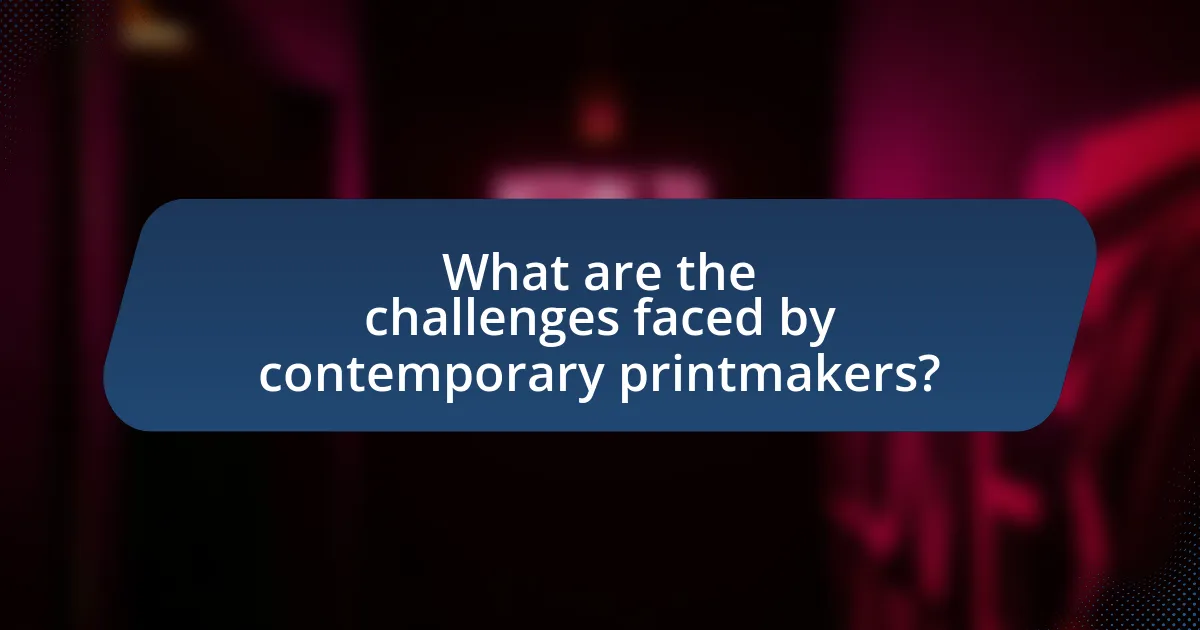
What are the challenges faced by contemporary printmakers?
Contemporary printmakers face several challenges, including the high cost of materials and equipment, competition from digital media, and the need to adapt to evolving technologies. The expense associated with quality inks, papers, and printing presses can be prohibitive, limiting access for emerging artists. Additionally, the rise of digital art has shifted audience preferences, making it essential for printmakers to innovate and incorporate new techniques to remain relevant. Furthermore, contemporary printmakers must navigate the complexities of copyright and intellectual property in a digital age, where reproducing and sharing artwork is easier than ever. These factors collectively impact the sustainability and visibility of printmaking as an art form.
What are the economic challenges in the printmaking industry?
The economic challenges in the printmaking industry include high production costs, competition from digital media, and fluctuating demand for printed art. High production costs arise from the need for specialized materials and equipment, which can deter new artists from entering the field. Competition from digital media has increased as consumers often prefer digital prints due to their lower prices and ease of access. Additionally, fluctuating demand for printed art can lead to inconsistent income for printmakers, as market trends shift towards more ephemeral forms of art. These factors collectively hinder the financial stability and growth potential of the printmaking industry.
How do funding and resources affect printmaking practices?
Funding and resources significantly influence printmaking practices by determining the availability of materials, tools, and access to professional development. Adequate funding allows artists to purchase high-quality inks, papers, and printing presses, which can enhance the quality and complexity of their work. For instance, artists with access to advanced technology, such as digital printing equipment, can experiment with innovative techniques that traditional methods may not allow. Additionally, financial support can facilitate workshops and educational programs, enabling artists to learn new skills and collaborate with peers, thereby expanding their creative horizons. Research indicates that artists in well-funded environments produce a higher volume of work and engage more frequently in experimental practices, showcasing the direct correlation between resources and artistic output.
What strategies can artists use to overcome financial barriers?
Artists can overcome financial barriers by diversifying their income streams through multiple avenues such as selling artwork online, offering workshops, and applying for grants. By utilizing platforms like Etsy or Saatchi Art, artists can reach a broader audience and generate sales without the overhead costs of a physical gallery. Additionally, conducting workshops allows artists to share their skills while earning income, and applying for grants from organizations like the National Endowment for the Arts can provide essential funding. According to a 2020 survey by the Artist Relief Fund, 70% of artists reported that diversifying their income helped them navigate financial challenges during economic downturns.
How do environmental concerns impact printmaking techniques?
Environmental concerns significantly impact printmaking techniques by prompting artists to adopt more sustainable practices. For instance, the use of eco-friendly inks, such as soy-based or water-based inks, has increased as artists seek to minimize harmful emissions and reduce toxic waste. Additionally, printmakers are increasingly utilizing recycled materials for substrates and experimenting with non-toxic solvents, which aligns with the growing emphasis on sustainability in the art community. Research indicates that these shifts not only address environmental issues but also resonate with audiences who value ecological responsibility in contemporary art.
What sustainable practices are being adopted in printmaking?
Sustainable practices in printmaking include the use of eco-friendly inks, recycled papers, and non-toxic solvents. Artists are increasingly opting for vegetable-based inks instead of petroleum-based ones, which reduces environmental impact. Additionally, many printmakers are sourcing paper from sustainable forests or utilizing scrap paper, minimizing waste. The adoption of water-based and biodegradable solvents further enhances sustainability by reducing harmful emissions. These practices are supported by organizations like the Green Arts Initiative, which promotes environmentally responsible methods in the arts.
How can printmakers reduce their ecological footprint?
Printmakers can reduce their ecological footprint by adopting sustainable materials and practices, such as using non-toxic inks and recycled papers. Non-toxic inks, which are derived from natural sources, minimize harmful emissions and waste, while recycled papers reduce deforestation and energy consumption associated with paper production. Additionally, printmakers can implement water-based cleaning solutions instead of solvent-based ones, further decreasing environmental impact. According to a study by the Environmental Protection Agency, switching to eco-friendly materials can significantly lower the carbon footprint of art production, demonstrating that sustainable practices are both feasible and beneficial for the environment.
What are the best practices for aspiring printmakers in contemporary art?
Aspiring printmakers in contemporary art should focus on mastering various printmaking techniques, such as lithography, etching, and screen printing, to develop a versatile skill set. Engaging in workshops and collaborating with established printmakers enhances technical proficiency and fosters creativity. Additionally, understanding the historical context and evolution of printmaking techniques informs contemporary practices, allowing artists to innovate while respecting tradition. Networking within the art community and participating in exhibitions can provide valuable exposure and feedback, essential for artistic growth.
How can artists effectively market their printmaking work?
Artists can effectively market their printmaking work by leveraging online platforms, participating in art fairs, and building a strong personal brand. Online platforms such as social media and e-commerce websites allow artists to reach a global audience, showcasing their work through high-quality images and engaging content. Participation in art fairs provides direct access to potential buyers and networking opportunities with other artists and galleries, enhancing visibility. Additionally, a strong personal brand, characterized by a unique artistic voice and consistent messaging, helps artists connect with their target audience and fosters loyalty. According to a survey by the National Endowment for the Arts, 70% of artists reported that social media significantly increased their visibility and sales, underscoring the effectiveness of these marketing strategies.
What resources are available for learning modern printmaking techniques?
Resources for learning modern printmaking techniques include online courses, workshops, and instructional books. Online platforms like Skillshare and Coursera offer courses taught by experienced printmakers, covering various techniques such as screen printing and lithography. Additionally, local art schools and community colleges often provide hands-on workshops that allow for practical experience. Instructional books, such as “The Printmaking Bible” by Ann d’Arcy Hughes and “Printmaking: A Complete Guide to Materials & Processes” by Beth Grabowski, serve as comprehensive references for both beginners and advanced practitioners. These resources collectively provide a structured approach to mastering modern printmaking techniques.
